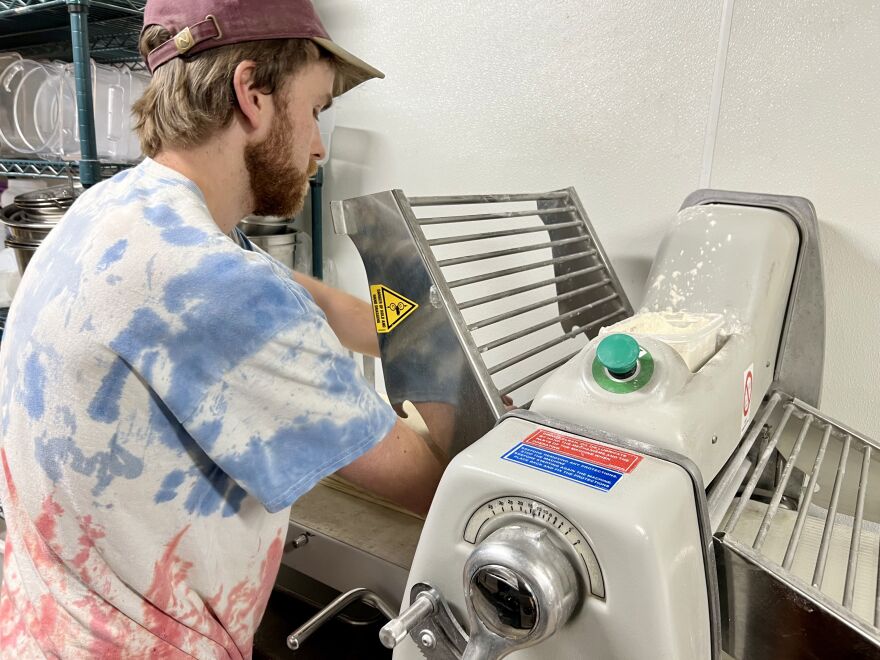As patrons lined up for a late afternoon pastry at Athens Bread Company, Tim McKenna prepped croissants. He pounded on a slab of dough and folded it over a stretched-out sheet of butter to create the pastries’ layers.
“God knows how someone figured out how to do all this but, once you get the hang of it, it’s just going through all the steps,” he said.
McKenna has owned the bakery for over a year now, and he loves to experiment with new menu items. They don’t always pay off. But, when he made his first loaf of bread out of chestnut flour last fall, he said it was an automatic autumn hit.
“People would line up for it. I couldn’t get enough flour,” McKenna said. “I would order some, make a bunch of loaves, and people would order them all up.”

McKenna originally got the flour from the nonprofit Rural Action’s Appalachian Staple Foods Collaborative. The organization has spent the last two years figuring out the best way to take chestnuts that Ohio farmers can’t sell fresh and turn them into something people will actually eat.
Through a North Central Region Sustainable Agriculture Research and Education grant, they’re working with local millers across the state to experiment with new ways to bring their harvest to more Ohioans — and prove that the crop is more than just a catchy line in a Christmas carol.
New ground
Amy Miller is a third-generation chestnut farmer, who manages Route 9 Cooperative in eastern Ohio. Every fall, her cooperative sells around 100,000 pounds of chestnuts. The group can hardly keep up with the demand.
“When we open the online store, we are pretty much sold out within a couple of weeks,” she said.
But around 10 to 20% of the cooperative’s crop can’t be sold fresh as culinary chestnuts due to their small size or blemishes.
Before, Miller didn’t have the right technology to make them into something profitable. Now, they’re dried, ground up, and processed into everything from pancake mix to chestnut beer to the flour that McKenna uses to make his chestnut loaves.

He’s bringing the chestnut-flavor baked good back next season, partially because it’s popular and partially, because it connects to Athens’ past.
“Chestnuts used to be the biggest tree in this area,” he said. “They were the kings of the forest around here, until blight knocked them out. So, to me, it's this kind of lost piece of our history.”
A climate-smart crop
This history is part of what Michelle Ajamian, network manager of Appalachian Staple Foods Collaborative, said makes investing in chestnut farming and processing so important.
When the region lost its chestnut trees, Ajamian said it also lost a great economic opportunity. Eastern Ohio doesn’t have a whole lot of flatland for growing row crops.
“But it's ideal for chestnuts. So, it could really help Appalachia, farming, economically,” Ajamian said. “It gives us a way to say, ‘Hey, there are sustainable ways to get what we need economically and in our diets from the land.’”
So, Ajamian is connecting farmers like Miller to actual millers, who have the right technology to process those small or blemished “Grade B” chestnuts.

The way she sees it: the better Ohio’s tools are for processing chestnuts, the better the market for the crop will be. And that could convince more Ohio farmers to grow something that has a really positive impact on the environment: chestnut trees capture carbon quickly, and they don’t disturb the soil the way some traditional row crops do.
“We need to look for ways that we can divert people's diets and also farm wealth away from these crops that are damaging the water and the soil and contributing to greenhouse gasses,” she said.
The future of chestnuts
Ajamian predicts it might take awhile until these connections translate to a big environmental impact. But, the project has made farmers like Miller hopeful it will at least lead to more chestnuts in local markets this year.
“That pancake mix is kind of like a gateway into knowing about chestnuts for people who maybe haven't grown up with that as like a part of their diet,” she said.
Still, Miller said she understands good things take time to grow. That’s chestnut farming, in a nutshell.


